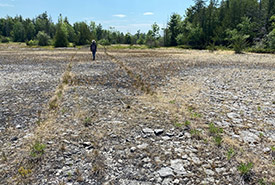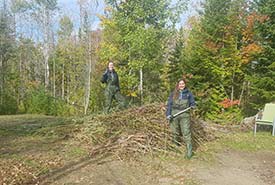Cockroaches and colours: Exercises in attention on Pelee Island

Woodburnings of some my favourite species on Pelee Island: the eastern banded tigersnail, broad-banded forestsnail, and striped whitelip. These snails are all nationally endangered and threatened by a range of factors including climate change, habitat loss and competition from introduced snails and slugs. (Photo by Hashveenah Manoharan/NCC intern)
On one of my first days working for the Nature Conservancy of Canada as conservation intern on Pelee Island, a cockroach had nestled itself into my copy of Mary Oliver’s collection of poems, Devotions. As a lifelong urbanite, my instinct was...
A thank you letter to the young professionals of conservation

The 2021 eastern Ontario team at Elbow Lake, ON (Photo by NCC)
Spring is one of the best times to be a conservation biologist with the Nature Conservancy of Canada (NCC). I get to dust off my field boots, turn off my laptop and get back outside. There is a beautiful rhythm to resuming field work, and my to-do...
The fossils of Camden East Alvar

A particularly exposed section of the Camden East Alvar, an NCC property just west of Kingston, Ontario. (Photo by NCC)
Doing field work in the middle of the summer can be hot, but doing it on an alvar feels even hotter. An ecosystem formed with little to no soil on top of limestone bedrock, alvars typically have large areas of low-lying vegetation and exposed...
Volunteers make Big Valley flourish

Volunteers and staff prior to planting (Photo by NCC)
The Qu’Appelle River Valley is one of Saskatchewan’s prominent scenic landscapes. Its picturesque slopes and waterways host a wide variety species and offer views unlike any other in the province. I’ve driven through this region...
Calling in the corps — the Canadian Conservation Corps

CCC participants cutting invasive phragmites stems (Photo by NCC)
They say that many hands make light work. Well, I don’t know if the hard-working young people who hauled brush, cut phragmites stems or collected buckets of acorns would tell you that the work was “light” but I can certainly say...
A throwback to working in Backus Woods

Forest canopy in Backus Woods, ON (Photo by Neil Ever Osborne)
I had the pleasure of working for the Nature Conservancy of Canada (NCC) for the summer of 2019 as a conservation technician out of the Norfolk County, Ontario, office. When I first came to Norfolk, I was expecting to see mostly farmland and...
Backpack Essentials: Don’t let the ticks bite!

Backpack Essentials (Image by NCC)
This blog post is part of the Backpack Essentials series, a series that explores the items that Nature Conservancy of Canada (NCC) staff carry with them when heading outside. It is inspired by the quarterly Nature Conservancy of Canada Magazine...
Private land conservation: Another option

One property that I helped monitor this summer stood out from the rest, with its old-growth forest and fern-covered forest floor. (Photo by NCC)
As this past summer’s Nova Scotia conservation engagement intern with the Nature Conservancy of Canada (NCC), I was given the opportunity to explore the province from one tip to the other, seeing parts of the province I had never seen...
Living out my passion for conservation

Brock Hussey (Photo by NCC)
I have always had a passion for nature, like many people in the conservation field. Growing up, I was always outside, surrounded by nature, observing the plants and animals around me. It wasn’t often you would find me without my eyes glued...
Making friends with the solitary bees

Blue orchard bee (Photo by Robert Engelhardt)
When you think of bees, your mind probably goes to honey, hives and stingers. But what if I told you that there was a species of bee, native to the Saskatchewan prairies, that didn’t make honey, live in a hive or (usually) sting? Mason bees...

